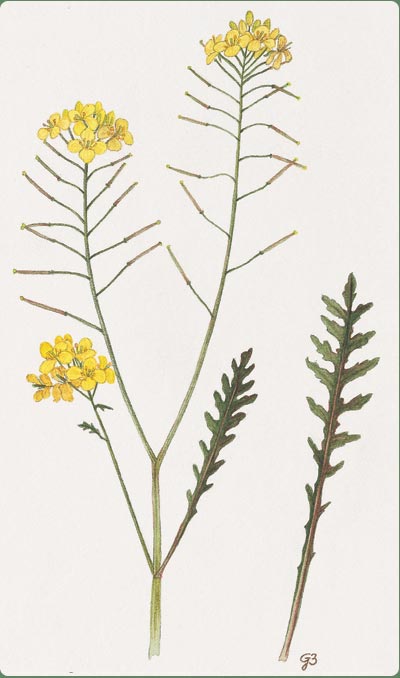Erucastrum palustre Erucastrum palustre (Pir.) Vis.
Family: Cruciferae Endemic species of the alkaline fens of the Friuli lowland. It has been described as a new species since 1855 by the naturalist Giulio Andrea Pirona with the name Brassica palustris. Like Armeria helodes, with which it shares the habitat,this species of neoformation differenziated during the creation of the lowland alkaline fens and their isoloation from the surrounding areas.
It has got spatulate leaves, more or less lobed, fleshy and glossy, growing in basal rosettes and on the stems. Generally it is not more than 100 cm high, even if older and more luxuriant specimens can be more than 150 cm high. It booms mainly in May- early June, when it is two years old.
The species was very common (certainly until the World War II) in the whole resurgence area of Friuli, characterizing in particular the most hydric aspects of the alkaline fens. For its relationship with the habitat created by the resurgence of the water table, the species has been used by Poldini to identify the association Erucastro-Schoenetum nigricantis.
Among all the species of the alkaline fens in Friuli, this one has suffered the most for the water table lowering and therefore it is endangered.
The total area covered by the species, which was of about 375 hectares at the end of the '60s and of 140 hectares in 1987, has diminished increasingly to 30 hectares and it is still getting smaller and smaller.
If that was mainly due to the soil plough up and to the fisheries construction until the '80s. In the last twenty years, after the site protection, the disappearance of whole sites has been caused by the modified ecological conditions. The species is present in at least ten small sites in seven different municipalities with no ecological links among them as they are separated by intensive farming areas.
Like Armeria helodes, the small number of specimens, the fragmentation of the sites and the disappearance of suitable habitats make Erucastrum palustre an endangered species in the near future if no measures will be taken to preserve it. The species is included in the Annex II of the Council Directive 92/43/EEC.

G. Bolognini © |

|